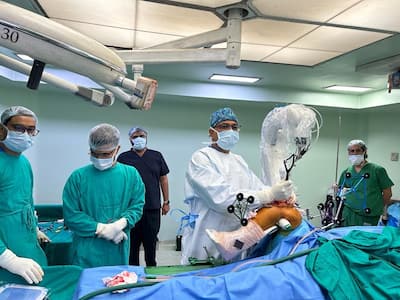
Read on to know more about Robotic Partial Knee Replacement Surgery: uses, benefits and the ideal candidate.
Robotic Partial Knee Replacement Surgery is considered when the patient has early-to-mid-stage osteoarthritis associated with symptoms such as knee pain, knee swelling, and knee locking. Because it is minimally invasive, robotic surgery is recommended for older patients.
Dr. Himanshu Gupta, who is the founder of AmiCare Hospital, recently performed Partial Robotic Knee Replacement Surgery on a 71-year-old woman on both her legs. The patient, Mrs Kusum Lata was able to walk slowly within 2-3 days after the surgery, and withing 2 weeks, she resumed walking properly. This is claimed to be first Partial Robotic Knee Replacement Surgery conducted in North India.
Lata recounts, “Initially, I experienced pain and swelling in my heels, so I sought advice from a doctor who informed me that my heel bone had overgrown. As time passed, my condition deteriorated, and the pain in my leg became unbearable, hindering my ability to walk.”
After evaluating her condition, Dr. Gupta recommended an X-ray, as heel pain shouldn’t radiate to the leg. The X-ray revealed a reduced gap in both her knees, which was further diagnosed as arthritis in a specific compartment of the knee. Then Partial Knee Replacement Surgery was suggested to improve her condition.
“I had my surgery on 11th September 2023 and within 2-3 days, I was able to walk slowly. By 2 weeks, I had resumed walking properly. The pain diminished following the treatment, and by diligently adhering to the prescribed medication and instructions, I experienced significant relief,” she adds.
To learn more about Robotic Partial Knee Surgery, we connected with Dr. Himanshu Gupta, MS. MCh Orth Specialized in Joint Replacement, Arthroscopy, and Sports Injury from AmiCare Hospital. Excerpts follow:
Q. Who is the ideal candidate for robotic partial knee surgery?
Partial knee replacement is a suitable option for patients suffering from arthritis localised to a single compartment of the knee. Typically, this procedure is not recommended for patients with a body mass index (BMI) exceeding 40, significant knee stiffness, or pronounced angular deformities. Those patients who don’t have intact knee ligaments or an untreated torn anterior cruciate ligament (ACL) are also not considered. Patients with rheumatoid arthritis affecting the entire joint are also less likely to be eligible.
Surgeons evaluate every case differently to gather information and determine whether robotic partial knee replacement surgery is the most suitable treatment option. One of the most important factors is that it causes less trauma and is minimally invasive so robotic surgery is sometimes favourable for patients over the age of 80, even when they do not meet all eligibility criteria.
There are no hard and fast rules, but in general, partial knee replacements are appropriate for patients over 40 years old who meet other eligibility criteria.
Q. What are the advantages of robotic partial knee surgery over traditional surgery methods?
Robotic partial knee replacement surgery compared to traditional procedures has numerous benefits. These advantages encompass:
READ RELATED: Treadmill Workouts: 7 Reasons Why You Should Start Treadmill Running Today
- Enhanced surgical planning: Specialised three-dimensional images are captured both in the preparatory phase and during the surgical procedure. These images aid the surgeon in meticulously planning the ideal type and positioning of the joint, ensuring precise size and fit.
- Greater precision: Robotic technologies increase the proficiency of the orthopaedic surgeon, enabling greater precision in the planning process, tissue removal, and implant placement.
- Optimal joint alignment: With the help of robotic technology, the surgeon can achieve improved alignment and positioning of the patient’s knee implant. This contributes to a joint replacement that feels more natural and reduces friction and wear on newly implanted joints.
However, robotic partial knee replacement surgery doesn’t completely rely on a robot. Instead, the robot functions as a guide, assisting the surgeon in executing the planned surgery.
In this process, the orthopaedic surgeon retains full control, utilising the robot as an additional surgical instrument. Throughout every phase of the surgery, the robot augments the surgeon’s expertise, ultimately contributing to better outcomes.
Q. How is partial knee surgery different from total knee replacement surgery?
Surgical intervention often becomes necessary to treat damaged and deteriorated knee joint tissues. The distinction between partial and total knee replacement surgery lies in the extent of the procedure.
Partial knee replacement surgery focuses solely on the damaged compartment of the knee, leaving the unaffected portions intact. In contrast, total knee replacement involves the replacement of all three compartments of the knee.
Partial knee replacement offers several advantages in terms of reduced bodily stress. It facilitates less extensive dissection of bone and soft tissue, resulting in minimal blood loss during the procedure. Additionally, patients undergoing partial knee replacements typically experience faster postoperative recovery.
The procedure for both types of knee replacement involves the removal of damaged cartilage and bone from the knee joint’s surface, followed by the insertion of artificial components crafted from various materials. Total knee replacement is usually recommended for individuals dealing with severe osteoarthritis or chronic knee pain.
If you talk about the complexity of the procedures with the advent of robotic surgery, surgeons can treat their patients much more efficiently and recovery time is getting less for the patients.
Total Wellness is now just a click away.
Follow us on
Don’t Miss Out on the Latest Updates.
Subscribe to Our Newsletter Today!
window.addEventListener(‘load’, (event) => {
$(‘#commentbtn’).on(“click”,function(){
(function(d, s, id) { var js, fjs = d.getElementsByTagName(s)[0]; if (d.getElementById(id)) return; js = d.createElement(s); js.id = id; js.src = “//connect.facebook.net/en_US/sdk.js#xfbml=1&version=v2.3”; fjs.parentNode.insertBefore(js, fjs);}(document, ‘script’, ‘facebook-jssdk’));
$(“.cmntbox”).toggle();
});
});








